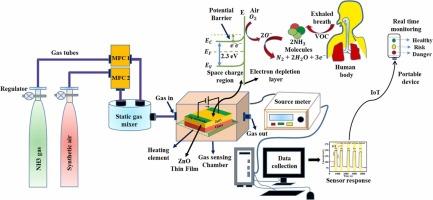Highly sensitive and selective ammonia (NH3) sensing by annealed pulse laser deposited (PLD) - ZnO thin films
IF 6.3
2区 材料科学
Q2 CHEMISTRY, PHYSICAL
引用次数: 0
Abstract
This work reports highly sensitive and selective ammonia (NH3) gas sensor development with a detection limit 5.2 ppm achieved by PLD-deposited ZnO thin film, annealed at 450 °C. At this annealing temperature, ZnO film exhibited a very high sensing response of 89 % on exposure to lowest NH3 concentration at 300 °C operating temperature. Moreover, a fast response time of 60 s and a recovery time of 65 s are recorded. Comparatively, the sensor response is 9 times higher (89 %) than the response obtained by unannealed ZnO thin film (10 %) for the same gas concentration. Additionally, the optimized film exhibits excellent selective detection towards NH3 gas as compared to other interfering gases (CO, H2, CO2, O2, NO2, C3H6O, C2H2, and CH4). Also, the sensor’s repeatability is examined over a multiple number of gas exposure cycles, and good stability is achieved. The physical properties of PLD-deposited ZnO films are systemically explored by using X-ray diffraction (XRD), Atomic force microscopy (AFM), Field emission scanning electron microscope ( FESEM), Raman spectroscopy, X-ray photoelectron spectroscopy (XPS) techniques, and electrical I-V measurement. The conducive performances of ZnO thin film annealed at 450 °C indicate a strong candidate for the detection of NH3 gas. Based on ultra-low detection limit and quantification ability under mixed gases exposure, annealed ZnO film exhibits a promising candidate for real-time exhaled breath NH3 monitoring for the identification of disease biomarkers like liver and kidney diagnosis application.

退火脉冲激光沉积(PLD) - ZnO薄膜的高灵敏度和选择性氨(NH3)传感
这项工作报道了高灵敏度和选择性氨(NH3)气体传感器的开发,其检测限为5.2 ppm,由pld沉积的ZnO薄膜,在450°C退火。在此退火温度下,ZnO薄膜在最低NH3浓度下(300℃)表现出89%的高传感响应。此外,还记录了60 s的快速响应时间和65 s的恢复时间。相比之下,在相同气体浓度下,传感器的响应(89%)比未退火ZnO薄膜的响应(10%)高9倍。此外,与其他干扰气体(CO, H2, CO2, O2, NO2, c3h60, C2H2和CH4)相比,优化后的膜对NH3气体具有良好的选择性检测。此外,该传感器的可重复性在多个气体暴露循环中进行了测试,并获得了良好的稳定性。采用x射线衍射(XRD)、原子力显微镜(AFM)、场发射扫描电镜(FESEM)、拉曼光谱(Raman)、x射线光电子能谱(XPS)技术和电I-V测量等方法,系统地研究了pld沉积ZnO薄膜的物理性质。450℃退火后的ZnO薄膜具有良好的性能,是NH3气体检测的有力候选材料。基于混合气体暴露下的超低检出限和定量能力,退火ZnO薄膜在实时呼气NH3监测中具有良好的应用前景,可用于肝脏和肾脏等疾病生物标志物的识别诊断。
本文章由计算机程序翻译,如有差异,请以英文原文为准。
求助全文
约1分钟内获得全文
求助全文
来源期刊

Journal of Alloys and Compounds
工程技术-材料科学:综合
CiteScore
11.10
自引率
14.50%
发文量
5146
审稿时长
67 days
期刊介绍:
The Journal of Alloys and Compounds is intended to serve as an international medium for the publication of work on solid materials comprising compounds as well as alloys. Its great strength lies in the diversity of discipline which it encompasses, drawing together results from materials science, solid-state chemistry and physics.
 求助内容:
求助内容: 应助结果提醒方式:
应助结果提醒方式:


